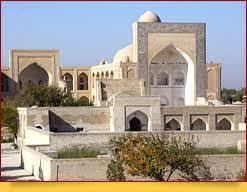
Bukhara
Explore Bukhara on foot
Buildings included in the UNESCO list, with a thousand-year history.
The tour includes the Ark Citadel, which is the residence of the Bukhara khans, the Kalyan minaret, known as the Tower of Death (in the Middle Ages, criminals were thrown to their deaths from the top) and the Samanid mausoleum of the 9th century.

dynastic mausoleum of the Samanids in the historical center of Bukhara (Uzbekistan), built at the turn of the 9th and 10th centuries

Madrassah of Abdullah Khan (uzb. Abdullaxon madrasasi) is a medieval building of a higher educational institution

The Chashma-Ayub mausoleum is a religious building in the center of Bukhara, it includes a mausoleum and a sacred spring.

Madrassah Nodir-Divan-Begi is a madrasah in Bukhara, part of the architectural ensemble of the 16th-17th centuries Lyabi-Khauz. You will relax with a cup of fragrant green tea in Lyabi-Hauz, a quiet square overlooking the pool, which was created in 1620. It sits in the shade of mulberry trees as old as the pool. This evening you will visit an open-air folklore show with dinner, which includes national dances, music performance on national instruments and a fashion show of national clothes
Explore Bukhara surrounds

The Emir's summer palace and the Chor-Bakr necropolis near Bukhara ("memorial complex of the four brothers"), also known as the City of the Dead.

The Sitorai-Mohi-Khosa Palace (Uzb. Sitorai Mohi Khossa Saroyi - Palace like the stars and the moon) is the country residence of the Emir of Bukhara, built in the late 19th - early 20th centuries.

Madrassah Caliph Niyozkuli (Niyazkuli) (better known as Chor-Minor - translated as Four Minarets

The Baha ad-Din complex is a cult ensemble located in the suburban area of Bukhara. The complex served as the center of the Nakshbandi dervish order.
